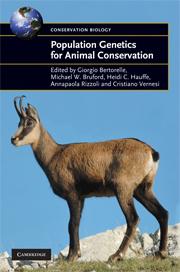14 results

Population Genetics for Animal Conservation
-
- Published online:
- 05 July 2015
- Print publication:
- 28 May 2009
Future directions in conservation genetics
-
- Book:
- Population Genetics for Animal Conservation
- Published online:
- 05 July 2015
- Print publication:
- 28 May 2009, pp 319-320
-
- Chapter
- Export citation
From genetic data to practical management: issues and case studies
-
- Book:
- Population Genetics for Animal Conservation
- Published online:
- 05 July 2015
- Print publication:
- 28 May 2009, pp 225-226
-
- Chapter
- Export citation
Epigraph
-
- Book:
- Population Genetics for Animal Conservation
- Published online:
- 05 July 2015
- Print publication:
- 28 May 2009, pp v-vi
-
- Chapter
- Export citation
Molecular approaches and applications
-
- Book:
- Population Genetics for Animal Conservation
- Published online:
- 05 July 2015
- Print publication:
- 28 May 2009, pp 121-122
-
- Chapter
- Export citation
Species index (common name)
-
- Book:
- Population Genetics for Animal Conservation
- Published online:
- 05 July 2015
- Print publication:
- 28 May 2009, pp 376-378
-
- Chapter
- Export citation
List of contributors
-
- Book:
- Population Genetics for Animal Conservation
- Published online:
- 05 July 2015
- Print publication:
- 28 May 2009, pp ix-xii
-
- Chapter
- Export citation
Acknowledgements
-
- Book:
- Population Genetics for Animal Conservation
- Published online:
- 05 July 2015
- Print publication:
- 28 May 2009, pp xiv-xiv
-
- Chapter
- Export citation
Species index (Latin name)
-
- Book:
- Population Genetics for Animal Conservation
- Published online:
- 05 July 2015
- Print publication:
- 28 May 2009, pp 379-381
-
- Chapter
- Export citation
Software index
-
- Book:
- Population Genetics for Animal Conservation
- Published online:
- 05 July 2015
- Print publication:
- 28 May 2009, pp 374-375
-
- Chapter
- Export citation
Frontmatter
-
- Book:
- Population Genetics for Animal Conservation
- Published online:
- 05 July 2015
- Print publication:
- 28 May 2009, pp i-iv
-
- Chapter
- Export citation
Statistical approaches, data analysis and inference
-
- Book:
- Population Genetics for Animal Conservation
- Published online:
- 05 July 2015
- Print publication:
- 28 May 2009, pp 23-24
-
- Chapter
- Export citation
Contents
-
- Book:
- Population Genetics for Animal Conservation
- Published online:
- 05 July 2015
- Print publication:
- 28 May 2009, pp vii-viii
-
- Chapter
- Export citation
Subject index
-
- Book:
- Population Genetics for Animal Conservation
- Published online:
- 05 July 2015
- Print publication:
- 28 May 2009, pp 382-396
-
- Chapter
- Export citation



